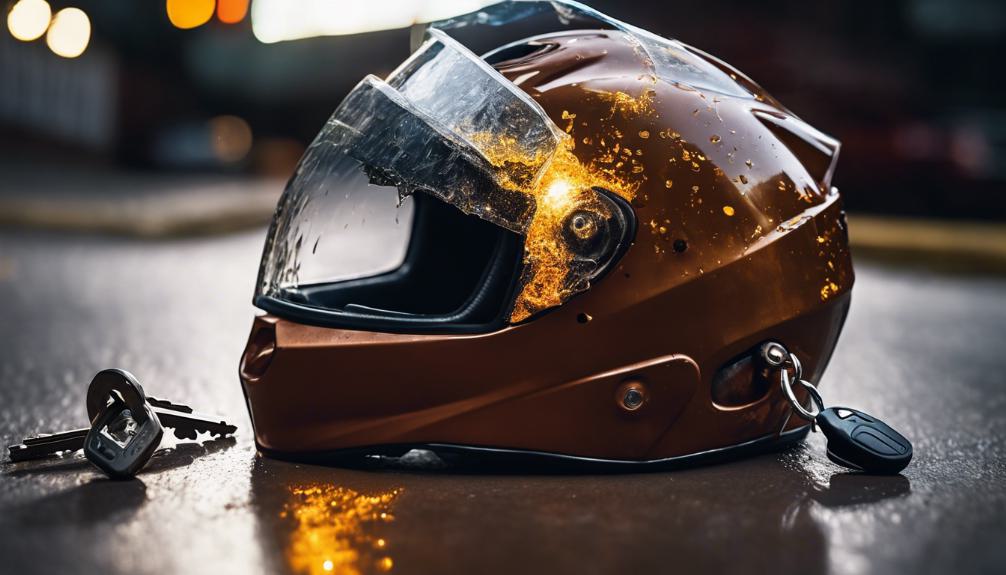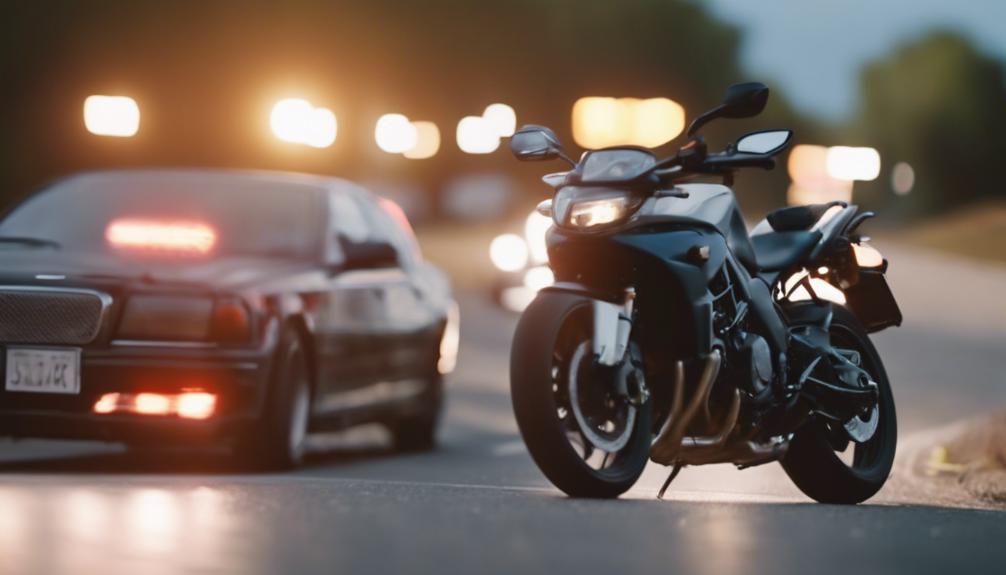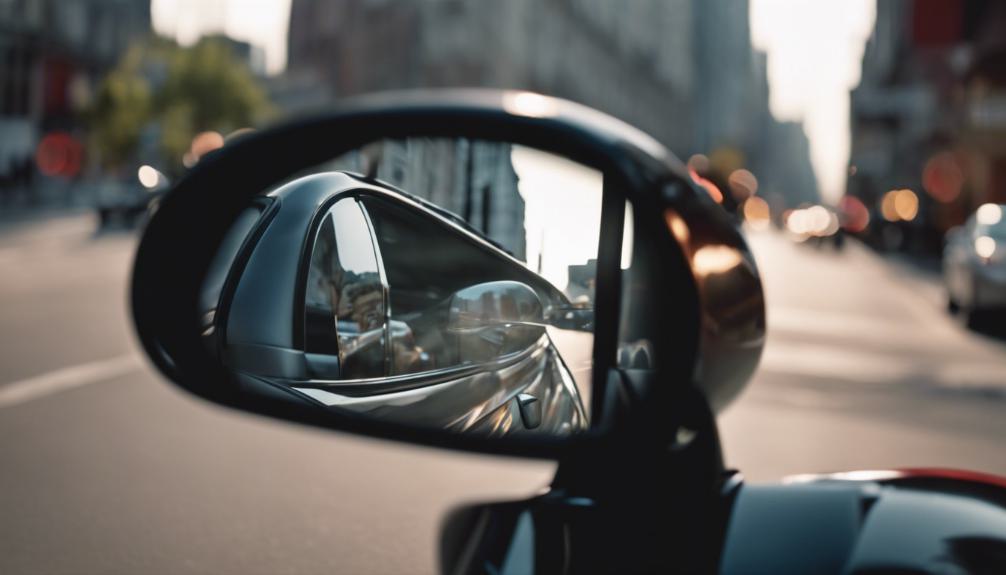Deadly Encounters: Cars Vs. Motorcycles Unveiled
In the intricate dance of road sharing, the dynamics between cars and motorcycles paint a harrowing picture of vulnerability and risk. The interaction between these two modes of transport is not merely about maneuverability or speed; it's a complex interplay of visibility, awareness, and often, a fatal misunderstanding of shared space. As we peel back the layers of causality behind the grim statistics of road fatalities, it becomes evident that the path to safer coexistence is fraught with overlooked details and underestimated dangers. Unraveling these factors could be the key to opening strategies that greatly reduce these deadly encounters, inviting a closer examination of the behaviors and adjustments necessary for both motorcyclists and automobile drivers.

Key Takeaways
- Motorcycles' small size greatly increases their risk of disappearing into vehicle blind spots, leading to accidents.
- Drunk riding is significantly linked to motorcycle fatalities, especially during nighttime.
- Speeding is a leading cause of motorcycle fatalities, with younger riders being particularly vulnerable.
- Failure to maintain a safe distance from motorcycles can lead to accidents due to their ability to slow down without visible brake lights.
Motorcycle Accident Causes

The primary causes of motorcycle accidents stem from the actions and decisions of both motorcyclists and car drivers, alongside inherent challenges associated with the motorcycle's size and stability. These incidents frequently occur due to a lack of awareness and understanding between the two parties, contributing to dangerous situations on the road. Motorcycles, being smaller and less stable than cars, are more susceptible to the consequences of sudden movements, such as swerving or abrupt stopping, which may not greatly impact a larger vehicle. Additionally, the failure of car drivers to maintain a safe distance from motorcycles exacerbates the risk of accidents. This issue is compounded by motorcycles easily disappearing into blind spots, making it important for both motorcyclists and car drivers to exercise increased vigilance and caution to mitigate these risks.
Drunk Riding Dangers

Among the myriad dangers on the road, drunk riding stands out as a significant contributor to motorcycle accidents, with impaired judgment and delayed reaction times leading to devastating outcomes. Alcohol impairment, affecting nearly a third of motorcyclists involved in fatal crashes, severely hampers a rider's ability to navigate safely. At night, the risk escalates, with impaired riders accounting for over forty percent of fatalities. The intoxication not only diminishes the rider's reaction capabilities but also compromises their risk assessment, making hazardous maneuvers more likely. Recognizable by erratic behaviors such as unnecessary swerving, drunk riding poses a grave threat not just to the rider but to everyone sharing the road.
Safe Distance Importance

Maintaining a safe distance between vehicles, particularly when following motorcycles, is important for preventing accidents on the road. Motorcycles possess the unique ability to slow down by downshifting rather than using brake lights, often leaving trailing drivers unaware of their deceleration. This characteristic, coupled with their smaller size and limited visibility, greatly increases the risk of collisions if a safe distance is not maintained. To enhance road safety, it is vital for drivers to provide more following space for motorcycles than they would for other vehicles. This practice gives drivers more time to react to unexpected movements or stops, thereby reducing the likelihood of accidents. Understanding and implementing the concept of a safe distance can save lives and prevent injuries on the road.
Blind Spot Hazards

Traversing the roads requires a keen awareness of blind spots, particularly when motorcycles, with their smaller profiles, are involved. Motorcycles can easily vanish from a driver's view within these blind spots, greatly increasing the risk of accidents. This hazard underscores the importance of drivers adjusting their mirrors to make sure maximum visibility and actively checking these areas before making lane changes or turns. Moreover, motorcyclists and drivers alike must be educated about the dangers posed by blind spots and adopt vigilant driving habits to mitigate these risks. Diligent mirror monitoring, coupled with shoulder checks, can serve as critical preventive measures. By fostering a mutual understanding and respect for each other's space on the road, both motorcyclists and car drivers can contribute to a safer driving environment.
Speeding Fatalities Analysis

Speeding greatly elevates the risk of fatalities in motorcycle accidents, with a significant proportion of these tragic outcomes involving younger riders. Data indicates that approximately one-third of motorcycle fatalities are directly linked to speeding, highlighting its critical impact on road safety. Specifically, riders aged 21 to 24 are disproportionately affected, with nearly half of fatalities in this age group occurring in incidents where speed was a factor. This alarming statistic underscores the urgent need for targeted safety campaigns and education to address the dangers of excessive speed among motorcyclists. The enhanced risk of losing traction and control at high speeds makes motorcycles inherently more vulnerable. Consequently, both motorcyclists and car drivers must exercise increased caution and responsibility to mitigate the deadly risks associated with speeding on our roads.
Motorcycle Stability Issues

Motorcycle stability issues greatly contribute to the risk of accidents on the road, stemming from their design and the physics of two-wheeled vehicles. Unlike cars, motorcycles are inherently less stable due to their reliance on the rider's ability to maintain balance, particularly at lower speeds or when coming to a stop. This instability is exacerbated by road conditions such as wet or uneven surfaces, which can greatly increase the risk of a slide or fall. Additionally, the lightweight nature of motorcycles means they are more susceptible to disturbances from wind gusts or the aerodynamic effects of passing larger vehicles, further challenging the rider's control. Proper training and experience are vital for managing these stability issues, but they remain a fundamental risk factor for motorcyclists.
Driver Awareness Gap

Often, the underlying cause of many vehicular accidents is a significant gap in driver awareness concerning the presence and behavior of motorcycles on the road. This gap can lead to misunderstandings or misjudgments in traffic, resulting in collisions. Motorcycles' smaller size and unique maneuverability characteristics mean they can easily be overlooked or misinterpreted by drivers of larger vehicles. The failure to recognize motorcycles in traffic flows or accurately gauge their speed and distance contributes to these incidents. Educating both motorcyclists and car drivers about the importance of heightened vigilance and understanding each other's road use patterns is critical. Proactive measures, including awareness campaigns and improved driver education programs, are essential steps towards bridging this awareness gap and reducing the incidence of accidents.
Nighttime Riding Risks

Riding after dark greatly amplifies the hazards motorcyclists face, due to decreased visibility and heightened difficulty for drivers to recognize and react to motorcycles on the road. The absence of daylight reduces the effectiveness of a motorcycle's visual cues, such as headlights and reflective gear, making it harder for car drivers to accurately judge the motorcycle's speed and distance. Additionally, the glare of oncoming headlights can momentarily blind motorists, further increasing the risk of accidents. Nighttime also introduces additional challenges such as poorly lit roads and obstacles that are harder to see, making navigation more perilous for motorcyclists. These factors collectively contribute to a higher incidence of accidents during night hours, underscoring the need for increased caution and awareness from both motorcyclists and vehicle drivers alike.
Reaction Time Impairment

As nighttime riding amplifies hazards through reduced visibility, impaired reaction time further compounds these risks, greatly affecting a rider's ability to respond to sudden road challenges. Impaired reaction time, often due to alcohol consumption, fatigue, or distractions, greatly jeopardizes safety. For motorcyclists, whose navigation depends heavily on split-second decisions, any delay in processing and reacting to changes in road conditions or the actions of other drivers can lead to catastrophic outcomes. Research indicates that alcohol-impaired riders are overrepresented in nighttime fatalities, highlighting the lethal combination of reduced visibility and delayed response. Even slight impairments in reaction time can transform manageable situations into deadly encounters, underscoring the critical need for sober and alert riding at all times.
Swerving as a Symptom

Swerving, a potentially dangerous maneuver, frequently signals impaired riding or the need to avoid road hazards. When motorcyclists engage in abrupt lateral movements, it's often a reaction to immediate threats such as debris, potholes, or unexpected changes in traffic flow. However, swerving can also be symptomatic of impaired riding, where the rider's judgment or physical coordination is compromised, often due to alcohol or drug influence. The distinction between reactive and impaired swerving is critical, as both pose different levels of risk to all road users. Reactive swerving, while potentially hazardous, is a controlled attempt to evade danger. In contrast, impaired swerving is unpredictable and increases the likelihood of collisions, underscoring the importance of recognizing and understanding the implications of this behavior on road safety.
Downshifting Without Braking

Downshifting without engaging the brake lights, a common practice among motorcyclists, can catch following drivers off guard, potentially leading to hazardous situations on the road. This technique allows riders to reduce speed by lowering gears instead of applying the brakes, thereby not activating the brake lights. While it's a skillful method for managing speed and conserving brake pad life, it poses significant risks in traffic. Car drivers, accustomed to deceleration cues like brake lights, may fail to notice a motorcycle's reduced speed until it's too late, increasing the risk of rear-end collisions. To mitigate these dangers, both motorcyclists and car drivers must practice heightened awareness and maintain a safe following distance, ensuring ample reaction time under varying traffic conditions.
Mirror Adjustment Tips

Understanding the risks associated with downshifting without braking highlights the importance of proper mirror adjustment for all drivers to enhance road safety. Effective mirror configuration allows for a wider field of vision, greatly reducing blind spots where motorcycles might otherwise go unnoticed. For car drivers, the side mirrors should be adjusted so the rear end of their vehicle is barely visible at the edge of the mirror. This setup broadens the view of the lanes beside and behind the vehicle. Rearview mirrors should be positioned to capture the full width of the rear window, ensuring a complete view of the road behind. These adjustments are vital for detecting motorcycles, especially when they decelerate without activating brake lights, lessening the risk of collisions and fostering safer road environments for all users.
Shoulder Check Necessity

Performing a shoulder check is a critical safety measure that allows drivers and motorcyclists to ascertain their blind spots are clear before changing lanes or making turns. This action is paramount in preventing accidents that occur due to the inherent visibility challenges posed by motorcycles' smaller size and the blind spots in larger vehicles. Despite advancements in vehicle technology, such as blind spot detection systems, the shoulder check remains an indispensable practice. It provides an extra layer of safety by ensuring that the area around the vehicle is entirely clear of motorcycles, pedestrians, or other obstacles. By integrating regular shoulder checks into their driving habits, both motorcyclists and vehicle drivers greatly reduce the risk of collisions, thereby enhancing road safety for all users.
Loss of Traction Concerns

Loss of traction, a critical issue for motorcyclists, markedly increases the risk of accidents, particularly in adverse weather conditions or on poorly maintained roads. This phenomenon, often a result of wet or oily surfaces, gravel, or debris, can lead to a motorcycle sliding uncontrollably. The smaller contact patch of motorcycle tires compared to car tires exacerbates this risk, highlighting the importance of regular tire maintenance and cautious riding in precarious conditions. Moreover, sudden changes in direction or speed can compromise traction, underscoring the need for riders to be vigilant and for car drivers to maintain a safe distance. By understanding and respecting the unique challenges motorcycles face regarding traction, both motorcyclists and car drivers can contribute to safer roads for everyone.
Encountering Speeding Motorcycles

Recognizing the dangers associated with loss of traction, it is equally important to address the risks posed by encountering speeding motorcycles on the road. Speeding motorcycles present unique hazards; their high velocity and smaller size increase the difficulty for car drivers to accurately perceive their speed and distance, leading to potential accidents. Approximately one-third of motorcycle fatalities involve speeding, underscoring the lethal risk it poses. Particularly among younger riders, the necessity for speeding is marked, with 49% of fatalities among those aged 21-24 involving such behavior. It's vital for car drivers to remain vigilant, especially in areas frequented by motorcyclists, and to anticipate the unpredictable movements that high-speed riding entails. Adjusting driving habits, such as increasing following distances and consistently checking blind spots, can mitigate the risk of deadly encounters with speeding motorcycles.
Frequently Asked Questions
How Do Weather Conditions Affect Motorcycle Riding Safety and the Frequency of Accidents Between Motorcycles and Cars?**
Weather conditions greatly impact motorcycle riding safety and incident rates with cars. Poor visibility, slippery surfaces, and unpredictable hazards increase risks, necessitating heightened awareness and caution from both motorcyclists and car drivers to prevent accidents.
What Role Does Road Infrastructure Play in Preventing or Contributing to Motorcycle Accidents, Particularly in Urban Vs. Rural Settings?**
Road infrastructure greatly influences motorcycle accident rates, with urban settings presenting more hazards due to higher traffic volumes and intersections, whereas rural areas may have challenges such as sharp turns and poorly maintained roads.
How Do the Advancements in Automobile and Motorcycle Technology, Such as Anti-Lock Braking Systems (Abs) and Vehicle-To-Vehicle Communication, Impact the Dynamics of Accidents Between Motorcycles and Cars?**
Advancements in automobile and motorcycle technology, such as ABS and vehicle-to-vehicle communication, have the potential to *reduce* the incidence and severity of accidents between motorcycles and cars by enhancing safety features and improving communication.
What Legal Measures, Such as Helmet Laws and Lane Splitting Regulations, Are Most Effective in Reducing the Number of Fatal Encounters Between Motorcycles and Cars?**
Legal measures like stringent helmet laws and clear regulations on lane splitting have proven effective in mitigating fatal accidents between motorcycles and cars. These policies directly address the risks and behaviors leading to collisions.
How Does the Psychological Aspect of Risk-Taking Behavior Differ Between Motorcycle Riders and Car Drivers, and What Impact Does This Have on Accident Rates?**
The psychological aspect of risk-taking behavior varies between motorcycle riders and car drivers, influencing accident rates. Motorcyclists often exhibit higher risk tolerance, which can lead to more accidents compared to the generally more cautious car drivers.
Conclusion
In summary, the interaction between cars and motorcycles on roadways poses important safety challenges, primarily due to the latter's vulnerability and visibility issues. Enhanced awareness among all road users, adherence to safe driving practices, and the implementation of preventive measures such as proper mirror adjustments and rigorous shoulder checks are vital. Addressing the dangers of drunk riding, speeding, and maintaining a safe distance can greatly mitigate accidents. Ultimately, a collective effort towards understanding and respecting each other's space on the road is essential for reducing fatalities and fostering a safer driving environment.

This post has been generated by AI and was not reviewed by editors. This is Not legal advice. Please consult with an attorney.




